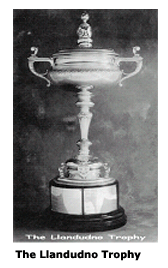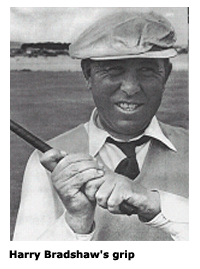|
(Beswick and Shankland had
provided the last – most startling – moment with a nett 65 ½). Three
of the short holes cost Ball and Gadd fours, but they reached the
last green with the knowledge that a putt, variously estimated at
from six to twelve yards, had to go down. And down it went, RAMMED
IN WITH SPIRIT – BY GADD”!
It went on: “The best gross was the 143 of H. E. Walker and Dick
Burton (Sale) (71-72). An unusual misfortune probably robbed them of
first place. Walker pulled his approach at the 8th into a bunker and
the ball came to rest in front of a brick the size of your fist.
Burton had to play both brick and ball and the latter, being more
resilient, bounded over the green into another bunker. When the ball
was finally holed out in seven the pair could claim to have been
unlucky, though vital putts continued to evade the hole.” Bricks are
not often found in bunkers these days but, under the current rule,
Dick could have removed the offending object without penalty of
course.
The nett scores of the first two pairings were:
Ball and Gadd (3) : 72 – 69
Beswick and Shankland (2 ½) : 75 ½ - 65 ½
Bill Shankland was another great character from those days. He was
an Australian who had represented his country at Rugby Union, Rugby
League, Swimming and Boxing and, when he came to England in the
early thirties with an international rugby team, he was snapped up
by Warrington to play in the English Rugby League. He was paid a
£1000 signing-on fee and £8 a week plus £6 a match. Contrast that
with the £2 10s wages paid to Miners at that time. Bill had a
successful eight seasons with Warrington and he loved the game but
it was said that his wife was so upset by the battering he took that
she chivvied him into turning to a less physical activity. He had a
clause inserted in his contract allowing him to take up a job as a
golf professional and he went to the West Lancashire club as
assistant to Bob Kenyon, before joining Haydock Park. He was a fine
player, but often struggled on the greens and this was to be his
downfall when in a position to challenge for the Open the following
year. I remember him experimenting with a putter that had a
45-degree angle in the top of the shaft to which he fitted a tube.
He then swung the putter while attempting to hold the tube firmly.
It had no chance of getting past the R&A of course. Later, when he
was pro at Potters Bar in Hertfordshire, he was a hard taskmaster to
his young assistant, making him open the shop at 8am and not close
until 8pm. The young man’s name was Tony Jacklin.
In September of that year, the day after the late Queen Mother
launched the liner named after her: Queen Elizabeth, an
international match commenced at the Llandudno Golf Club (Maesdu).
It was the first time that all four home countries had competed
together following the format of the amateur international played a
week earlier at Royal Porthcawl. In that series L.G.Crawley of
Brancepeth Castle was in the England team that won the trophy,
beating all three of the other nations.
 Llandudno Urban District Council donated the Llandudno Trophy for
the professional four-nation tournament, which was to replace the
matches that had been played before the Open each year. The England
team, captained by Percy Alliss and containing five Ryder Cup
players, emulated the amateurs and defeated Wales, Ireland and
Scotland to take the new trophy. Llandudno Urban District Council donated the Llandudno Trophy for
the professional four-nation tournament, which was to replace the
matches that had been played before the Open each year. The England
team, captained by Percy Alliss and containing five Ryder Cup
players, emulated the amateurs and defeated Wales, Ireland and
Scotland to take the new trophy.
Jimmy Adams captained the Scottish team that England had beaten
twice that year, but I was not involved in the earlier encounter,
which took place prior to the Open at Sandwich. An absentee from
both of the matches was Henry Cotton, who was the second winner of
the Vardon Trophy in 1938; home internationals never seemed to fit
into his schedule.
 At Llandudno I won two of my singles and halved the other, after
having been dormie two down to Bill Holley of Ireland. I partnered
the long hitting Dunlop Southport champion, Don Curtis to win our
match against Wales, during which Don drove the green at the 310
yard 4th. We also beat the Scotland pairing of Tom Haliburton, the
famous Wentworth professional (then at Prestwick, St Nicholas) and
Hamish Balingall of Balmore. In the Irish twosome that beat us 2 & 1
was Harry Bradshaw who was to lose a play off with Bobby Locke in
the 1949 Open, after the famous ‘broken bottle’ incident in the
second round may well have cost him the title. Another memorable
thing about Harry was his unusual ‘anti-hooking’ grip – a
three-finger overlap with only the thumb and forefinger of the right
hand in contact with the club shaft.
He was the professional at Portmarnock GC, Dublin for forty years. At Llandudno I won two of my singles and halved the other, after
having been dormie two down to Bill Holley of Ireland. I partnered
the long hitting Dunlop Southport champion, Don Curtis to win our
match against Wales, during which Don drove the green at the 310
yard 4th. We also beat the Scotland pairing of Tom Haliburton, the
famous Wentworth professional (then at Prestwick, St Nicholas) and
Hamish Balingall of Balmore. In the Irish twosome that beat us 2 & 1
was Harry Bradshaw who was to lose a play off with Bobby Locke in
the 1949 Open, after the famous ‘broken bottle’ incident in the
second round may well have cost him the title. Another memorable
thing about Harry was his unusual ‘anti-hooking’ grip – a
three-finger overlap with only the thumb and forefinger of the right
hand in contact with the club shaft.
He was the professional at Portmarnock GC, Dublin for forty years.
NEXT |

 Llandudno Urban District Council donated the Llandudno Trophy for
the professional four-nation tournament, which was to replace the
matches that had been played before the Open each year. The England
team, captained by Percy Alliss and containing five Ryder Cup
players, emulated the amateurs and defeated Wales, Ireland and
Scotland to take the new trophy.
Llandudno Urban District Council donated the Llandudno Trophy for
the professional four-nation tournament, which was to replace the
matches that had been played before the Open each year. The England
team, captained by Percy Alliss and containing five Ryder Cup
players, emulated the amateurs and defeated Wales, Ireland and
Scotland to take the new trophy.
 At Llandudno I won two of my singles and halved the other, after
having been dormie two down to Bill Holley of Ireland. I partnered
the long hitting Dunlop Southport champion, Don Curtis to win our
match against Wales, during which Don drove the green at the 310
yard 4th. We also beat the Scotland pairing of Tom Haliburton, the
famous Wentworth professional (then at Prestwick, St Nicholas) and
Hamish Balingall of Balmore. In the Irish twosome that beat us 2 & 1
was Harry Bradshaw who was to lose a play off with Bobby Locke in
the 1949 Open, after the famous ‘broken bottle’ incident in the
second round may well have cost him the title. Another memorable
thing about Harry was his unusual ‘anti-hooking’ grip – a
three-finger overlap with only the thumb and forefinger of the right
hand in contact with the club shaft.
He was the professional at Portmarnock GC, Dublin for forty years.
At Llandudno I won two of my singles and halved the other, after
having been dormie two down to Bill Holley of Ireland. I partnered
the long hitting Dunlop Southport champion, Don Curtis to win our
match against Wales, during which Don drove the green at the 310
yard 4th. We also beat the Scotland pairing of Tom Haliburton, the
famous Wentworth professional (then at Prestwick, St Nicholas) and
Hamish Balingall of Balmore. In the Irish twosome that beat us 2 & 1
was Harry Bradshaw who was to lose a play off with Bobby Locke in
the 1949 Open, after the famous ‘broken bottle’ incident in the
second round may well have cost him the title. Another memorable
thing about Harry was his unusual ‘anti-hooking’ grip – a
three-finger overlap with only the thumb and forefinger of the right
hand in contact with the club shaft.
He was the professional at Portmarnock GC, Dublin for forty years.